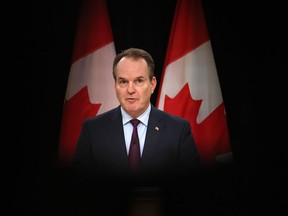Latest report should leave Bank of Canada comfortable with decision to hold
Article content
October’s jobs report will leave the Bank of Canada more “comfortable” with its decision to hold interest rates at 5 per cent, economists say.
Statistics Canada’s employment report on Nov. 3 showed the jobless rate jumped to 5.7 per cent from 5.5 per cent, higher than expected. The economy generated a net gain of 17,500 jobs, falling short of estimates of 25,000.
Advertisement 2
Article content
Article content
“The rise in the unemployment rate suggests that some slack is gradually building up in the labour market, which should help ease some of the upside pressures on wages,” said Charles St-Arnaud, chief economist at Alberta Central.
Average hourly wages, which eased to a 4.8 per cent increase year over year from five per cent in September, will also be on the central bank’s radar.
These numbers are important because policy makers believe a tight and overheated jobs market and rising wages stoke demand and inflation.
When it held rates on Oct. 25, the central bank said, “Governing Council wants to see downward momentum in core inflation, and continues to be focused on the balance between demand and supply in the economy, inflation expectations, wage growth and corporate pricing behaviour.”
Simon Harvey, head of currency analysis at Monex Europe and Canada, said the deceleration in wage growth “should translate into a continued decline in the BoC’s measures of core inflation.”
Here’s what economists say about the latest jobs numbers and what they mean for the Bank of Canada and interest rates.
Article content
Advertisement 3
Article content
Andrew Grantham, CIBC Economics
“Weakness in economic activity appears to be slowly filtering through to a softer labour market, with job growth slightly weaker and the unemployment rate marginally higher than expected in October . . . . Overall, today’s report is further evidence that more rate hikes are not necessary to cool the economy, and combined with a weaker U.S. figure as well could see market expectations for interest rate cuts brought forward earlier into 2024.”
Olivia Cross, Capital Economics
“The more modest rise in employment and essentially unchanged hours worked in October suggest that labour demand is easing gradually. And with the unemployment rate rising again thanks to strong labour supply growth, the Bank of Canada should feel more confident that wage pressures will continue to ease.”
Related Stories
-

When to expect a Bank of Canada rate cut
-

What the economists say about GDP
James Orlando, TD Economic
“When the Bank of Canada decided to hold rates at five per cent last week, it did so because of a notable slowing in economic momentum. While this has been apparent in reduced consumer spending and a weakening housing market, the labour market left the BoC wanting more. But, given the rise in the unemployment rate and continued weakening in the underlying details, today’s report is likely to make the BoC feel more comfortable about its decision to hold. Looking forward, we are expecting this employment trend to continue, while high rates and persistent inflation make the case for the BoC to remain on hold in December.”
Advertisement 4
Article content
Charles St-Arnaud, Alberta Central
“With some progress made in October to create some slack in the labour market and slower wage growth, the likelihood of further rate hikes in the near future has diminished. Our view remains that the policy rate has likely peaked and that the Bank of Canada will stay on the sideline and watch previous rate increases work their way through the economic system and reduce inflationary pressures.”
Nathan Janzen, RBC Economics
“The BoC will still be cautious about easing off on the monetary policy brakes while inflation is still high. But signs of softening in labour markets should reinforce the decision to pause rate hikes for now and increase the odds that the next rate change will (eventually) be a cut. Our own base-case assumes the overnight rate will begin to move gradually lower in the second half of next year.”
Simon Harvey, head of currency analysis, Monex Europe and Canada
“The re-emergence of slack in the labour market is … starting to weigh on wage growth, which fell from 5.2 per cent to five per cent year over year (for permanent employees). This should translate into a continued decline in the BoC’s measures of core inflation, which if confirmed would support our view that the BoC has now concluded its hiking cycle and will now rely on below potential growth in guiding inflation back to target. This moves the market’s spotlight onto when the next change in policy will occur. In this case, that is an interest rate cut. In our view, the BoC is unlikely to ease before Q2 next year, but there is a risk that if growth conditions crater and lead to a more substantive unwind in the labour market, thus weighing on wage growth and the consumption outlook for 2024, that the BoC is forced to ease policy back to neutral as early as Q1.”
Tu Nguyen, RSM Canada
“Combined with GDP data earlier this week, October’s job report show that the Bank of Canada’s previous rate hikes are effectively cooling the economy, and no further rate hike would be required.”
• Email: gmvsuhanic@postmedia.com
Bookmark our website and support our journalism: Don’t miss the business news you need to know — add financialpost.com to your bookmarks and sign up for our newsletters here.
Article content
Job gains fall short: what economists say
2023-11-03 14:36:44






Comments
Postmedia is committed to maintaining a lively but civil forum for discussion and encourage all readers to share their views on our articles. Comments may take up to an hour for moderation before appearing on the site. We ask you to keep your comments relevant and respectful. We have enabled email notifications—you will now receive an email if you receive a reply to your comment, there is an update to a comment thread you follow or if a user you follow comments. Visit our Community Guidelines for more information and details on how to adjust your email settings.